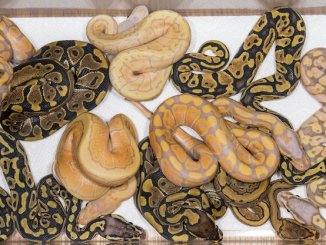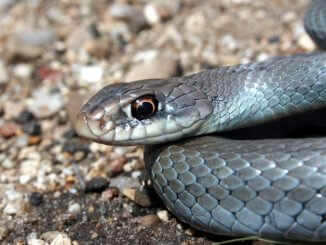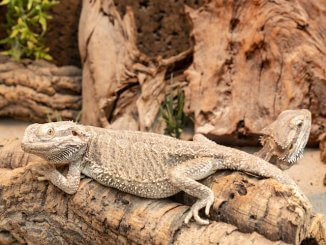Reptiles are fascinating and unique animals that interest people of all ages.
As one of the oldest and most diverse groups of animals, reptiles have many interesting qualities.
Despite some species making excellent pets, most reptiles are not domesticated. Because of this, there is a lot we have yet to learn about them. But, what we do know about reptiles only makes them more interesting.
Do you want to learn more about our scaly neighbors? Continue reading for 19 reptile facts you most likely didn’t know…
Reptile Facts
1. The Reptile Family Includes: Lizards, Turtles, Alligators, Crocodiles and Snakes.
Reptiles are a group of land-dwelling animals that includes: lizards, turtles, crocodilians (e.g. alligators, crocodiles and gharials) and snakes.
2. Every Reptile Has Scales.
Modern reptiles have changed a great deal from their ancestors, but all species today have scales. Scales are made of keratin, the same material that forms hair and feathers. They prevent reptiles from drying out in the sun while also providing tough protection against the teeth and claws of other animals.
As well as scales, all reptiles share several traits that distinguish them from other animals:
- They are covered in tough, hard scales. These scales are found in the top layer of their skin and help prevent water loss, while protecting them from the sun and predators.
- Reptile shells are covered in a tough calcium layer, which can either be hard or leathery.
- All reptiles have three or four chambered hearts. Lizards, snakes, and turtles have hearts with three chambers (two atria and one ventricle). Crocodilians have four chambers (two atria and two ventricles).
3. There Are 10,000+ Reptile Species.
There are over 10,000 known species of reptiles around the world. This makes them more diverse than mammals and amphibians. They are found on all continents except Antarctica and they thrive in deserts, oceans, and cities.
4. The Saltwater Crocodile Is The Heaviest Reptile.
Reptiles come in many different shapes and sizes.
The smallest reptile is the lizard Brookesia nana, which is only 0.53 inches long. The largest reptile is the saltwater crocodile, which can weigh over a ton.
5. The Reticulated Python Is The Longest Reptile.
Not as heavy as the saltwater crocodile, the reticulated python is considered the longest living reptile.
The world record was a 32 foot reticulated python that was found in Indonesia in 1912.
A group of reptiles known as the titanosaurs claim the title as the longest reptiles ever discovered, though they went extinct 65 million years ago. The Argentinosaurus is estimated to be the longest dinosaur of all, measuring 130 feet from head to tail.
6. Reptiles Are Cold-Blooded.
Reptiles do not create their own body heat so are considered ‘cold-blooded’. They must move to warm areas, or bask in the sun, to raise their body temperature. They will move into the shade if they start to get too warm.
They must bask in order to raise their internal body temperature to have enough energy to hunt, mate, escape from predators, and digest food. Depending on the external temperature, reptiles adjust their basking time to maintain an optimal body temperature.
A warmer environment means that a reptile will need to bask less, while a cooler environment means it will bask more.
The common myth that their blood is actually cold is not true. A reptile that has been in the sun for an hour will have warm blood, but is still considered a cold-blooded animal!
7. Some Species Can Smell Using Their Tongues.
Most reptiles, including all types of turtles, tortoises, and crocodilians, smell through their nostrils. Just like mammals.
However, snakes and most lizards smell by using their tongues.
They collect scent particles on their tongues and move them to a special organ in the roof of their mouths called the vomeronasal organ. They then tastes the scent. This may seem like a complicated way to smell, but it lets them determine the direction of a scent more accurately. They can also detect pheromones from other reptiles with their tongues.
8. Reptiles Do Not Sweat.
Reptiles do not have sweat glands, so they cannot sweat, even if they get too hot. Not being able to sweat helps reptiles conserve water in hot environments.
Instead, reptiles cool themselves by moving to shade, burrowing, drinking, or going into the water.
Crocodiles cool down by basking with their mouths open. This is known as gaping and keeps their heads cool while the rest of their body warms up.
Desert snakes keep cool by burrowing underneath the hot top layer of sand to the colder levels below.
9. Not All Reptiles Lay Eggs.
Reptiles breed through internal fertilization. Some species (e.g. garter snakes) congregate in large numbers to breed, while others find a single mate. After breeding, all reptiles give birth in one of three ways:
- Turtles, alligators, and ball pythons are oviparous so lay shelled eggs. The young develop in the eggs and then hatch later. Laying shelled eggs gives reptiles an advantage as these eggs can withstand harsh environmental conditions. Eggs are also easy to hide and protect the young until they hatch and can fend for themselves.
- Rattlesnakes and garter snakes are ovoviviparous so develop eggs that incubate inside the mother. The young hatch internally and then are born live.
- The viviparous lizard does not lay eggs, instead the young develop directly and are born live.
It is true that most reptiles lay eggs. Most species lay eggs and leave them to fend for themselves. But, crocodilians protect their eggs and care for the newborns when they hatch.
10. Venomous Snakes Are The Most Dangerous Reptile.
Venomous snakes are responsible for the most reptile-caused deaths worldwide, followed by crocodiles.
Snakebites cause over 100,000 deaths globally each year. These deaths happen mostly in developing countries and remote areas where access to rapid healthcare and anti-venom is limited.
Crocodiles and alligators are responsible for killing nearly 1,000 people per year. Nile and Saltwater crocodiles hold the highest rates of fatal attacks.
11. Reptiles Are 350 Million Years Old.
Reptiles are some of the oldest animals and are much older than mammals and birds. They first appeared during the Carboniferous period, about 350 million years ago.
These early reptiles were called cotylosaurs and looked similar to modern-day lizards. Over the next 150 million years cotylosaurs and their relatives would evolve into the lizards, crocodilians, turtles, snakes, and tortoises we see today.
Crocodiles are often called “living fossils” because they look almost identical to their ancient ancestors from the Jurassic period, about 200 million years ago!
12. Tortoises Are The Longest-Living Reptiles.
Of all the reptile species, tortoises live the longest.
The oldest land animal alive today is a 189-year-old Aldabra tortoise named Jonathan.
180 years is an especially long lifespan, even for a tortoise! But many species can routinely live for over 80 years. They are able to do this because of their slow metabolisms, tough shells, and few health problems.
13. Some Reptiles Can Change Color.
Chameleons are known for their ability to change color.
Most chameleons are brown or green, but they can rapidly change their skin color to patterns of yellow, red, purple, black, blue and orange.
Chameleons change colors for many possible reasons, including communication, stress, and camouflage. The true reason for their ability to change color is still largely unknown.
14. Reptiles Are Not Amphibians.
Reptiles and amphibians look very similar, and they even live in the same habitats. Yet, they are two separate and distinct groups of animals.
Amphibians lay soft, jelly-like eggs in water and hatch as aquatic larvae that breathe with gills.
Reptiles lay hard-shelled eggs on land, and their hatchlings do not have gills.
15. Reptiles Shed Their Scales.
Reptiles have scales that do not grow with their body. Because of this, they need to shed their old scales as they increase in size. This is the same way tarantulas and insects molt their exoskeletons.
Individuals that are shedding may temporarily lose their appetites and become sluggish or shy.
16. Reptiles Are Not Invertebrates.
Reptiles are vertebrate animals with a backbone, just like fish, mammals, birds and amphibians.
The flexibility of some snakes can make it seem like they do not have any bones at all. However, they do have vertebrae. Snakes have several hundred vertebrae that let them bend and coil in ways that would be impossible with a smaller number of back bones.
17. Reptiles Are Ectothermic.
Ectotherms are animals who cannot generate their own body heat.
Mammals and birds are endotherms, meaning they can keep their bodies warm no matter the outside climate. Reptiles are ectothermic. This is why reptiles are sluggish in cooler temperatures and bask in the sun to warm up. When their environment is cold, they do not have enough energy to move quickly or even digest food.
18. Not All Reptiles Eat Meat.
It is a common myth that all reptiles eat the same food.
All crocodilians and snakes are pure carnivores that only eat other animals and animal eggs.
Most turtles and tortoises are omnivores and herbivores, eating fruits, vegetables, seeds, and some small animals.
Lizards are a varied bunch that feed primarily on insects or vegetation. Leopard geckos and fence lizards are insectivores and do not eat any plant matter, while bearded dragons and iguanas enjoy fruits and veggies.
19. October 21st Is National Reptile Awareness Day.
Reptile awareness day is a day meant to engage the public about reptile conservation, education, diversity and importance.
The greatest threat to reptiles is habitat destruction and human activity.
If you want to celebrate Reptile Awareness Day, take a trip to a nearby zoo or park to learn more about your local reptiles and maybe even see some for yourself.
Let us know in the comments if any of these facts surprise you?
Sources
https://www.open.edu/openlearn/nature-environment/introducing-mammals/content-section-6.1
https://www.stlzoo.org/animals/abouttheanimals/reptiles
https://reptile-database.reptarium.cz/
http://umich.edu/~zhanglab/publications/2006/Grus_2006_Bioessays_28_709.pdf
https://www.alligatorfarm.com/wp-content/uploads/2015/03/Mouth-Gaping.pdf
https://uci.edu/powerofi/snakebite/index.php
http://www.iucncsg.org/pages/Crocodilian-Attacks.html
https://www2.gwu.edu/~darwin/BiSc151/Reptiles/Reptiles.html
https://www.guinnessworldrecords.com/news/2019/2/introducing-jonathan-the-worlds-oldest-animal-on-land-561882
https://www.ncbi.nlm.nih.gov/pmc/articles/PMC2214820/
http://www.doc-developpement-durable.org/file/Elevages/Serpents/Reptile%20Habitat%20Management%20Handbook.pdf
https://cpb-us-e1.wpmucdn.com/blogs.cornell.edu/dist/7/3643/files/2013/09/Herps-I-1ld0k49.pdf
https://news.utoledo.edu/index.php/06_05_2018/lizards-immediately-adjust-sun-basking-behavior-to-offset-warmer-temperatures
http://citeseerx.ist.psu.edu/viewdoc/download?doi=10.1.1.694.1650&rep=rep1&type=pdf





Really interesting article. I’ve been researching different types of lizards; so, some of the information presented in the article is familiar to me; but, there some of it was new. Like October 21st is National Reptile Awareness Day. I’ve never heard it mentioned before.
Very nice list of facts, for novice and pro alike!
Bearded Dragons are omnivores they eat small insects such as crickets and roaches. Also they have been known to eat baby frozen mice